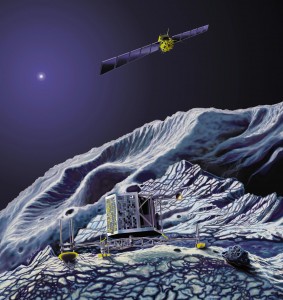Welcome Back Rosetta: The Dynex MAS31750 Awakens
The ESA’s comet chaser Rosetta has just today awoken from a long deep sleep on its comet chasing (and landing) mission. The solar powered spacecraft was launched back in 2004. It is based on the Mars Mariner II (itself based on the Voyager and Galileo) spacecraft design of the early 1990s (when the mission was first conceived.) Main differences include using very large solar arrays versus a RT (Radioisotope Thermal Generator) and upgraded electronics.
In order to conserve power on its outward loop (near Jupiter’s orbit) most all systems were put to sleep in June of 2011 and a task set on the main computer to waken the spacecraft 2.5 years later and call home. The computer in charge of that is powered by a Dynex MAS31750 16-bit processor running at 25MHz, based on the MIL-STD-1750A architecture.
A reader recently asked why such an old CPU design is still being used rather then say an x86 processor. As mentioned above the Rosetta design was began in the 1990’s, the 1750A was THE standard high reliability processor at the time, so it wasn’t as out of date as it is now that its been flying through space for 10 years (and 10 years in the clean room). The 1750A is also an open architecture, no licenses are or were required to develop a processor to support it (unlike x86). Modern designs do use more modern processors such as PowerPC based CPUs like the RAD750 and its older cousin the RAD6000. Space system electronics will always lag current tech due to the very long lead times in their design (it may be 10 years of design n the ground before it flies, and the main computer is selected early on). x86 is used in systems with 1) lots of power, and 2) somewhat easily accessible. Notably the International Space Station and Hubble. x86 was not designed with high reliability and radiation tolerance in mind, meaning other methods (hardware/software) have to be used to ensure it works in space.
Currently the ESA designs with an open-source processor known as the LEON, which is SPARC-V8 based.



January 21st, 2014 at 1:47 am
I came across the following document covering a design of the Rosetta Automatic Descent System. Which apparently is controlled by an RTX2010.
January 21st, 2014 at 3:21 am
Very nice thank you, I saw some of the various instruments are FPGA based, with a 16-bit RISC processor on the FPGA. The RTX2010 is another very popular aerospace computer (Based on the Novix Forth Processors)
November 12th, 2014 at 1:58 am
[…] and begin its decent to a comets surface. The orbiter is powered by a 1750A processor by Dynex (as we previously discussed). The lander is powered by two Harris RTX2010 16-bit stack processors, again a design dating back […]
August 9th, 2016 at 6:31 am
Just tripped over this article – brings back some memories! I developed most of the microcode for the 31750 when at GEC in Lincoln, UK. A most interesting project, similar to that described in ‘The Soul of a New Machine’. Only a small team of engineers (seven IIRC) developed this thing from the ground up.